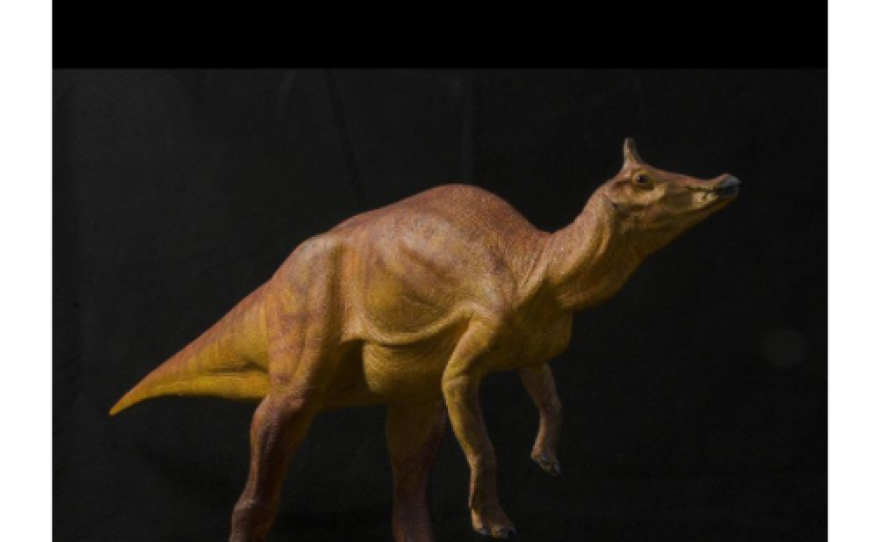UPDATE: 10:30 a.m., April 17, 2017
It's looking like California will soon have a state dinosaur: Augustynolophus morrisi.
A bill to add the duck-billed dinosaur to the list of state insignia has passed the Assembly and is now headed to the state Senate.
Augustynolophus morrisi eats a plant-based diet.
"They've been nicknamed the cows of the Cretaceous because they were apparently gregarious animals, living in large social groups," said Tom Deméré, the paleontology curator at the San Diego Natural History Museum.
They could walk on two legs, but they were primarily four-legged animals with shorter front legs, Demere said.
California already has 33 state insignia including a state lichen, lace lichen, and a state fabric, denim.
The bill also requires approval from the governor.
On Monday's Midday Edition, we speak to Deméré about the proposed state dinosaur.
His California had a stay dinosaur, you'd figure it would have to love the coast, and be vegan, and have a face perfect for a duck lips selfie. We think we found one. State lawmakers are close to naming a duck billed 35 along vegetarian prehistoric reptile as the state's dinosaur. It's skeleton was discovered 80 years ago in Southern California and is estimated to have roamed the state 86 million years ago. "KPBS Midday Edition" host Maureen Cavanaugh spoke with the paleontology go curator at the San Diego history Museum about the proposed stay dinosaur. She began by asking how to pronounce its name. Augustynolophus morissi. The species name. What does that name mean? The species name refers to Bill Morris, who was a vertebrate peer he leaned Holly just -- was a vertebrate paleontologist at Occidental College. The genus name is named after a family in Los Angeles who has donated to the L.A. County Museum. The lophus refers to a group of species the dinosaur is associated with. There has been talk of a nickname. Do you have any suggestions? I don't. I'm sure the kids will come up with nicknames for this dinosaur. For the sake of this interview, let's call him Augy. Remains of a duckbilled dinosaur have also been found in San Diego County. Can we determine what kind of duckbilled dinosaur that was? Unfortunately, our material duckbilled dinosaurs are really fragmentary. We have a single vertebra from La Jolla Bay, and then there are isolated like bones in Carlsbad as well as some tail vertebrae from Carlsbad. And parts of a jaw from point Loma. So it is scattered. Not the same individual. These scattered remains don't really preserve these anatomical features that are diagnostic. For a duckbilled dinosaur, they are here but we don't know who they were. Howard there remains discovered? Going back to the discussion about coastal. 75 million years ago, we were coastal. The rocks of that age, the preserved fossils are also marine deposits. In other words, settlements that accumulated in the ocean. The dinosaur remains represent individuals that were unlucky enough for them but lucky enough for us that the remains were washed out to see where they sank to the seafloor essentially and were preserved, and are now exposed on the surface. And, Augy, from the Marine formation up near Fresno, those fossils are also found in marine deposits. Dinosaurs are very rare in California primarily because we don't have land deposits of that age, but we have a lot of marine deposits. Listeners can see a reconstruction of what the proposed stay dinosaur looks like. They can see it on our website, KPBS.ORG. He is not a fearsome looking dinosaur. Maybe a little bit goofy looking. What do we know about how this creature lives? It belongs to this group of dinosaurs, duck tail dinosaurs. These are plant eating dinosaurs. They have been nicknamed the cows of the crustaceans, because they were apparently gregarious animals living in large social groups. And they were plant eaters. Although they could walk on two legs, they were primarily four-legged animals. They have relatively shorter from legs compared to back legs. They could chew their food alone -- unlike a lot of other dinosaurs. They just sort of like a crocodile bite, and swallow. These animals were plant eaters, and were able to use this very interesting dental battery, teeth in their mouth, to actually process, let's say, tough plant material. People may wonder why California may want a stay dinosaur. What is the purpose? I don't know. We have a state fossil and have had for years the sabertooth cats. Other states actually have stay dinosaurs. And it was felt that, why not California have a stay dinosaur? It already has a Twitter account, so do you think that one of its purposes might be to get kids and people more interested in science? Well I would hope so. I would hope it would not just be a frivolous notion. I think if people, certainly schoolchildren, are asked to do a report on a stay dinosaur, I think it's a window or avenue for them to actually get interested in dinosaurs and maybe more broadly science. The state assembly has already approved this, the state Senate, and now the governor has to sign it. How would you like this boat to turn out? I would hope it would be unanimous. It would be nice to see both sides of the aisle come together and agree on this. I've been stoking -- speaking with Tom, paleontology curator. Thank you. Thank you, Maria. Stay with us. Still ahead, we hear the story of a pair of Syrian refugees now living in San Diego. Sisters that had to leave their beloved musical instruments behind when they left their home country. It is 10 minutes until 1:00. You are listening to "KPBS Midday Edition."






